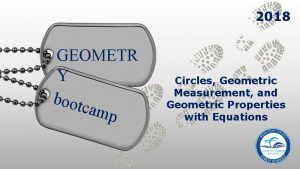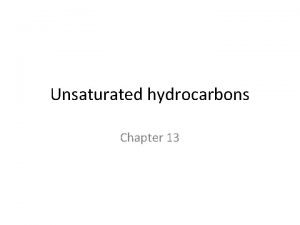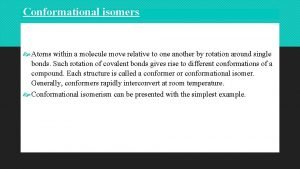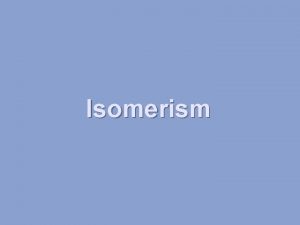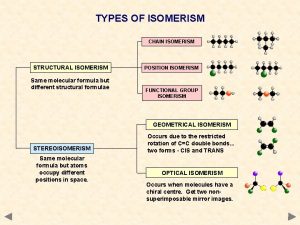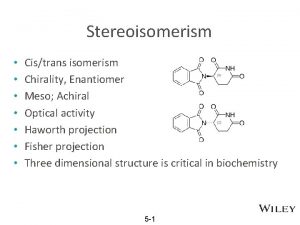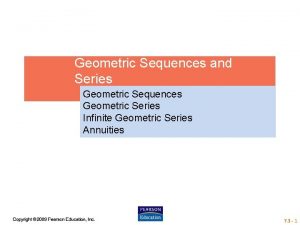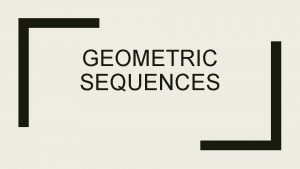cistrans isomerism EZ isomerism Why is geometric isomerism






- Slides: 6

cis/trans isomerism E/Z isomerism

Why is geometric isomerism important? In many instances, the shift from one geometric structure to another turns out to have profound chemical or biochemical significance. The chemistry of vision provides an interesting example. As you may know from biology, the retina is our light detector at the back of the eye. It contains 11 -cis-retinal, a compound derived from vitamin A. When light reaches the retina, the cisretinal compound rapidly flips into its the trans-isomer, and the process gives out a signal to nerve cells and hence to the brain. Then, an enzyme catalyzes the reverse process by flipping transretinal back to the cis-isomer, ready for the next light signal. This is the role of cis-trans isomerism in vision.

Visual cycle The visual cycle is a circular enzymatic pathway, which is the front-end of phototransduction. It regenerates 11 -cis-retinal. For example, the visual cycle of mammalian rod cells 1. all-trans-retinyl ester + H 2 O → 11 -cis-retinol + fatty acid; RPE 65 isomerohydrolases 13 2. 11 -cis-retinol + NAD+ → 11 -cis-retinal + NADH + H+; 11 -cis-retinol dehydrogenases 3. 11 -cis-retinal + aporhodopsin → rhodopsin + H 2 O; forms Schiff base linkage to lysine, -CH=N+H 4. rhodopsin + hν → metarhodopsin II ; 11 -cis photoisomerizes to all-trans rhodopsin + hν → photorhodopsin → bathorhodopsin → lumirhodopsin → metarhodopsin I I 5. metarhodopsin II + H 2 O → aporhodopsin + all-trans-retinal 6. all-trans-retinol + NADPH + H+ → all-trans-retinol + NADP +; all-trans-retinol dehydrogenases 7. all-trans-retinol + fatty acid → all-trans-retinyl ester + H 2 O; lecithin retinol acyltransferases (LRATs)14 Steps 3, 4, 5, 6 occur in rod cell outer segments; Steps 1, 2, and 7 occur in retinal

In organic chemistry, cis/trans isomerism (also known as geometric isomerism, configuration isomerism, or E/Z isomerism) is a form of stereoisomerism describing the orientation of functional groups within a molecule. In general, such isomers contain double bonds, which cannot rotate, but they can also arise from ring structures, wherein the rotation of bonds is greatly restricted. Cis-but-2 -ene Trans-but-2 -ene Alicyclic compounds can also display cis/trans isomerism. As an example of a geometric isomer due to a ring structure, consider 1, 2 -dichlorocyclohexane: cis-1, 2 -dichlorocyclohexane Trans-1, 2 -dichlorocyclohexane

Cis and trans isomers often have different physical properties. These differences can be very small, as in the case of the boiling point of straightchain alkenes, such as 2 -pentene, which is 37°C in the cis isomer and 36°C in the trans isomer. The two isomers of butenedioic acid have such large differences in properties and reactivities that they were actually given completely different names. The cis isomer is called maleic acid and the trans isomer fumaric acid.

� The cis/trans system for naming isomers is not effective when there are more than two different substituents on a double bond. The E/Z notation should then be used. Z (from the German zusammen) means "together" and corresponds to the term cis; E (from the German entgegen) means "opposite" and corresponds to trans. � Whether a molecular configuration is designated E or Z is determined by the Cahn-Ingold-Prelog priority rules; higher atomic numbers are given higher priority. For each of the two atoms in the double bond, it is necessary to determine the priority of each substituent. If both the higher-priority substituents are on the same side, the arrangement is Z; if on opposite sides, the arrangement is E. (E)-But-2 -ene (Z)-1 -bromo-1, 2 -dicholroethene 6

